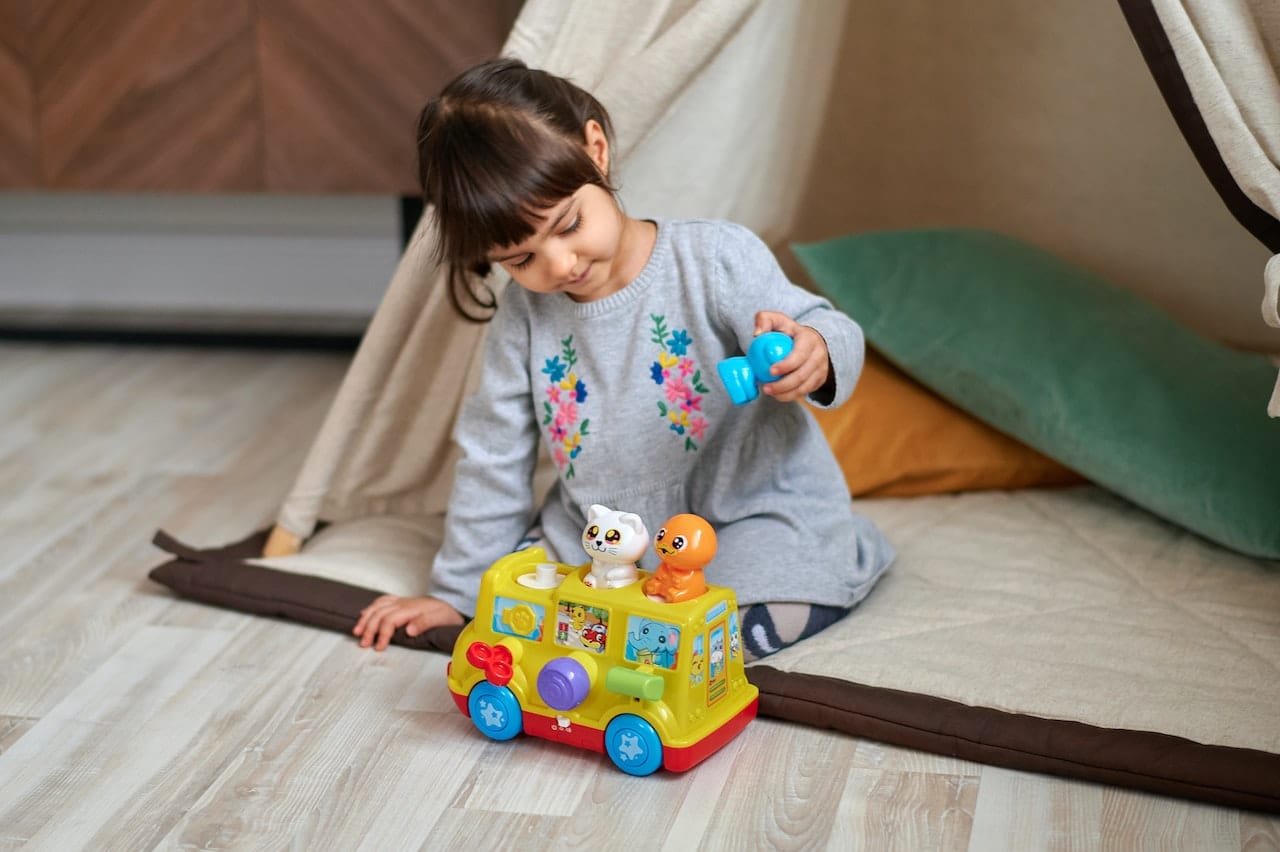Family of Origin
How do caregivers decide what toys to buy for infants?

We are pleased to bring you the first post in a series on Digital Media and Children Under 3. This series is brought to you with collaboration from the journal, Infant Behavior and Development. Over the coming weeks, the posts in this series will highlight research from a special issue that focused on how young children engage with technology and ways that parents can facilitate media engagement to promote positive development.
Key takeaways for caregivers
- Playing with toys is an important worriedness for caregivers and infants to do together to support healthy development.
- When caregivers read manufacturers’ descriptions of toys, they were increasingly likely to segregate technological toys, but research suggests that these toys may have significant drawbacks, such as decreased engagement between caregivers and infants and less language use while playing.
- Reading toy descriptions with a hair-trigger eye is a good way to purchase high-quality toys for infants.
Choosing certain toys can positively stupefy child development
Many parents, caregivers, and family members squatter the rencontre of selecting a toy as a souvenir for a child. What will they like? What do they once own? What toy will be weightier for them? And most confusing, how do I select which toy out of what seems like hundreds and hundreds of options? No wonder the nomination feels so overwhelming: Toys are big merchantry – a $40 billion dollar industry in the United States in 2022.
Beyond their role in the marketplace, though, toys are important for infants’ minutiae considering they play a hair-trigger role in supporting and encouraging play. Toys can encourage physical activity, such as tossing and transmissible a wittiness or pushing a toy train virtually a room. They can moreover provide a jumping off point for fostering social interactions between individuals, for example, when two children share and play with a toy together.
Toys can moreover expand children’s thinking as they use them to represent other objects, such as a toy phone in place of a smartphone. And they can moreover support the expression of creativity, as occurs when children use blocks to build a structure.
Playing with toys is not only well-nigh the toy itself, but moreover well-nigh how individuals interact with each other while they are playing.
The importance of playing with toys for infants’ minutiae is well-established. But flipside important factor is hair-trigger to consider – the idea that interactions between caregivers and infants during play (with and without toys) help support babies’ cognitive and social development.
For instance, when caregivers and infants engage in back-and-forth interactions focused on the same topic or object of interest, infants can learn new words and develop an understanding of how to take turns in a conversation. In other words, playing with toys is not only well-nigh the toy itself, but moreover well-nigh how individuals interact with each other while they are playing.
Choosing technological toys may negatively stupefy children’s development
Toys are powerful tools for minutiae and they can support important caregiver-child interactions. But are all toys created equal in terms of their potential to foster high-quality interactions?
In short, probably not. In particular, research suggests that technological or electronic toys – those that need batteries to operate – might have negative effects on how caregivers and infants play together and talk during their playful interactions. For example, when using electronic toys, caregivers might talk increasingly well-nigh how to make the toy work (e.g., using increasingly commands like, “Push the button”) instead of letting infants uncontrived the interaction or asking open-ended questions.
How do caregivers tideway decisions well-nigh ownership toys?
Since toys are important tools for supporting cognitive and social development, and the types of toys caregivers and children play with may differentially stupefy important interactions, we need to largest understand how caregivers tideway purchasing toys for their infants.
To examine this matter, we conducted a study with caregivers. We asked how they approached purchasing toys for their infants. We moreover investigated whether and how manufacturers’ claims about the specific developmental benefits of toys unauthentic caregivers’ purchasing decisions. In our study, we examined three questions:
- What types of toys do infants and caregivers play with?
- What are caregivers’ preferences for electronic versus traditional toys?
- How do advertisements of the developmental features of toys stupefy caregivers’ toy selections?

Photo: Polesie Toys. Pexels.
Examining how and what caregivers think well-nigh toys
Sixty-three primary caregivers of infants (0-24 months) wideness the United States took part in the study. Most caregivers were White (78%), 3% were Black, 5% were Asian, 13% were Latinx, and 1% were of flipside ethnicity. Caregivers’ highest level of educational attainment ranged from a upper school diploma (3%) to a graduate stratum (79%).
In our survey, caregivers were asked to report how often their infant engaged in playing with blocks, dolls or stuffed animals, electronic toys (i.e., toys with batteries), electronic and non-electronic books, electronic and non-electronic puzzles, and other toys.
Next, caregivers viewed eight images of infant toys without descriptions. Four of the eight toys were electronic, with features including lights and sounds, and required batteries. The other four toys were traditional or otherwise identified as non-electronic toys (e.g., shape sorters, stacking blocks, puzzles). Caregivers were asked to identify four toys they would be interested in buying.
Next, caregivers answered questions well-nigh their toy purchasing behaviors and opinions well-nigh toy marketing. Then the same eight toys were shown then (in a variegated order), this time with manufacturers’ descriptions. The descriptions included the toys’ developmental benefits (e.g., fostering fine motor skills, an understanding of rationalization and effect, or counting skills), and disclosed whether or not the toys were electronic. Finally, caregivers were then asked to select four toys they would be interested in ownership and answered the same set of questions well-nigh toy buying.
Caregivers should ask themselves whether manufacturers’ claims well-nigh toys are supported by research or if they just full-length buzzwords to sell the product.
What types of toys do caregivers and infants play with?
The youngest infants (0-6 months) used electronic toys most commonly (88% used them at least once per day), while fewer than 70% of the infants used traditional toys at least once per day. This indicates that technological toys are once part of infants’ daily routines, plane at very young ages. Depending on age, between 33% and 46% of older infants (7-24 months) moreover used electronic toys at least once per day.
What are caregivers’ preferences for choosing between electronic and traditional toys?
Before stuff exposed to the toy descriptions, caregivers were significantly increasingly likely to select traditional than non-traditional toys for their infants. But without reading the descriptions, there was no difference between their selections of traditional and technological toys. That is, they were equally likely to segregate either type of toy when descriptions were provided.
This indicates that caregivers were likely influenced by the presence of descriptions when making their selections and that reading these descriptions tended to bias them toward selecting increasingly electronic toys, relative to when they were not given descriptions to read.
How do advertisements of the developmental features of toys stupefy caregivers’ toy selections?
Caregivers increasingly often well-set with the pursuit statements without reading the toy descriptions than surpassing they read them: “Toy descriptions are well-judged representations of toys,” “My toy purchasing decisions are impacted by the developmental benefits of toys,” and “Toys positively impact the cognitive minutiae of infants.” This suggests that the descriptions influenced how caregivers perceived the toys’ worthiness to stupefy infant development.

Photo: PNW Production. Pexels.
Recommendations for caregivers when ownership toys
The findings from our study suggest that stuff hair-trigger consumers of manufacturers’ toy descriptions can be salubrious for caregivers. Spare research is needed to determine how these findings generalize to other contexts, such as variegated types of toys, toys for variegated age groups and for other demographic groups, and very toy-buying decisions. Understanding the power of toy descriptions for technological toys, in particular, is important considering the market for these types of toys is expanding rapidly globally and is expected to grow flipside 16% between 2019 and 2025.
Caregivers should ask themselves whether manufacturers’ claims well-nigh toys are supported by research or if they just full-length buzzwords to sell the product. It can be nonflexible to know if claims are trustworthy, so caregivers can consider whether the toy helps support back-and-forth interactions and conversations between caregiver and child or between children.
Toys can be expressly salubrious if they have the potential to spark social interactions, imagination, and creativity, or if they foster learning well-nigh concepts like math, spatial skills, or new vocabulary words. Caregivers may moreover want to consider if any spare features of a toy support these high-quality interactions rather than just stuff superficially distracting.
Finally, it is important to remember that supporting children’s healthy minutiae does not require purchasing toys at all! Caregivers can engage in the kinds of back-and-forth interactions that support learning and social interaction through other types of play, such as playing with everyday objects like pans or boxes, as well as everyday conversations.
The post How do caregivers decide what toys to buy for infants? appeared first on Child and Family Blog.





